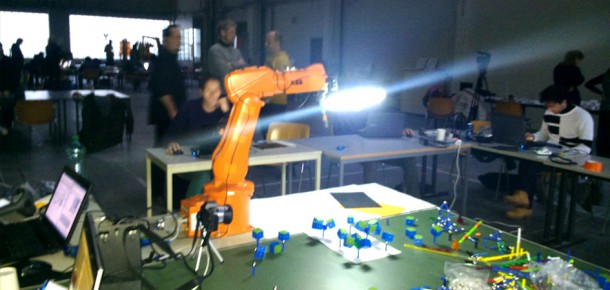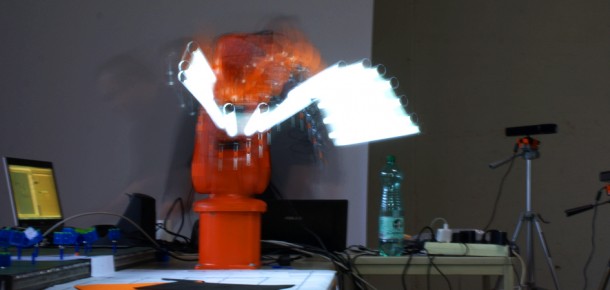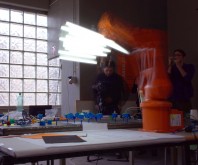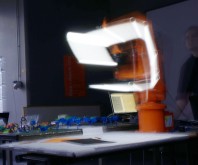RIA
Robots in Architecture Workshop
Vienna 2 – HAL
Tutors:
Organizer:
Location:
Dates:
Thibault Schwartz
RobArch2012
Vienna
14-16 December 2012
With the occasion of the RobArch2012 conference we had the pleasure of attending one of the 8 concurrent workshops held all over Europe on the theme of robotic fabrication use in architecture. Our workshop, Vienna I: Man Machine Cohabitation was conducted by Thibault Shwartz and was a great opportunity to have a hands on experience on how to control and program industrial robots. The workshop lasted only a few days, form the 14th to the 16th of December 2012, but it was an experience to remember. Our workshop was hosted at a facility of TUVienna in a space shared with the Vienna III workshop, where Brandon Kruysman and Jonathan Proto from SCI-Arc had no less than 3 Staubli robots working together in stitching freeform drawings on a freeform surface.
For us the workshop couldn’t have come at a better time. We had just ordered our own small ABB IRB 140 robot and we were eager to know if we will able to tame the beast, especially after one tiresome day at the ABB offices in Vienna where we had a small training in RobotStudio and saw that programming a robots isnt such an easy task after all. But we expected some better results from our workshop were we were supposed to work within Grasshopper to control the robot. And our expectations were surpassed by HAL, a plugin for grasshopper that enabled us to not only understand the way that a robot thinks but also gave us a very flexible tool to control its movement.
The workshop started very abruptly with a small introduction in robotics given by Thibault and a very fast paced training session into how to use the plugin in grasshopper and how to generate the code for the robot. Even though our workshop’s robot might have been the smallest we had been given access inside the black box of robotic fabrication. The aim of our workshop was that each participant would be able to write up his own code for a specific movement of the robot. And at the end of the first day we were one of the two who had some code ready to run and made the robot move. The robot itself had a tool with a magnet that could pick up small cubes and place them onto other magnetic cubes. We envisioned a small architectural structure that would be built by the robot and tried (with some success) to let him do it. Although at some points the robot needed some human help the experiment was quite successful.
We did learn a lot from this first experiment regarding finesse techniques for picking up and placing the cubes and Richard Dank from TUGratz developed his own improved version of the pick and place application. On the second day we marveled at more pick and place applications and took a sneak peak into the Vienna III workshop workflow. And quite frankly we were pleased with our choice of workshop. As we found out later, our workshop was the only one where you really had the liberty to do anything you want to the robot and had a direct access to the robot and its programming. All the other workshops dealt with another kind of workflow where the participants could develop or modify an existing geometry that was later passed on through a black box that validated through simulation the result and then the tutors processed the robot code and run it through the robot controller.
After our first success in controlling the robot we tried to tackle a much greater task, a real-time control of the robot using a Kinect sensor that would read the position of ones right arm wrist and move the robot according to the movements of the arm. Easier said than done. We had to go through several iterations and a few Grasshopper plugins to deliver a script that finally somewhat worked. It was still full of bugs but it got the job done. After another few iterations we cleaned up the code, fine-tuned the human movement so that the lag of the software would be accounted for and fired up a few long exposure shots of the robot wielding a light saber.
Attending this workshop made us even more confident that choosing a robot as a digital fabrication machine is a good idea and that the industrial robot has a great potential for architectural applications. It has always been like this, the robot is a very flexible machine, and it can be trained to do almost any task, opening up a great range of possibilities for creative architectural applications.










[…] Europe, including Eth Zurich, Stuttgart, TuDelft and Graz. We had the pleasure of attending the Vienna II workshop where we used HAL to controll from Grasshopper an industrial workshop. It was a great moment and a […]